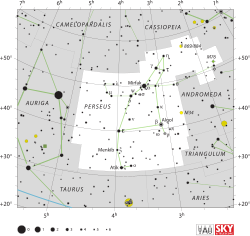Gamma Persei
| Observation data Epoch J2000.0 Equinox J2000.0 |
|
|---|---|
| Constellation | Perseus |
| Right ascension | 03h 04m 47.79074s |
| Declination | +53° 30′ 23.1687″ |
| Apparent magnitude (V) | 2.93 |
| Characteristics | |
| Spectral type | G8III + A2V |
| U−B color index | +0.45 |
| B−V color index | +0.70 |
| Variable type | EA |
| Astrometry | |
| Radial velocity (Rv) | +2.5 km/s |
| Proper motion (μ) |
RA: +0.51 mas/yr Dec.: –5.92 mas/yr |
| Parallax (π) | 13.41 ± 0.51mas |
| Distance | 243 ± 9 ly (75 ± 3 pc) |
| Absolute magnitude (MV) | –1.50 (–1.23/0.01) |
| Orbit | |
| Period (P) | 14.6 yr |
| Semi-major axis (a) | 0.144" |
| Eccentricity (e) | 0.785 |
| Inclination (i) | 90.9° |
| Longitude of the node (Ω) | 244.1° |
| Periastron epoch (T) | 1991.08 Besselian |
|
Argument of periastron (ω) (secondary) |
170.0° |
| Details | |
| γ Per A | |
| Mass | 2.7 M☉ |
| Surface gravity (log g) | 2.83 cgs |
| Temperature | 5,170 K |
| Metallicity [Fe/H] | –0.19 dex |
| Rotation | 5,350 days |
| Rotational velocity (v sin i) | 50.0 km/s |
| γ Per B | |
| Mass | 1.65 M☉ |
| Temperature | 7,895 K |
| Other designations | |
| Database references | |
| SIMBAD | data |
Gamma Persei (Gamma Per, γ Persei, γ Per) is a binary star system in the constellation Perseus. The combined apparent visual magnitude of the pair is +2.9, making it the fourth-brightest member of the constellation. The distance to this system has been measured using the parallax technique, giving an estimate of roughly 243 light-years (75 parsecs) with a 4% margin of error. About 4° to the north of Gamma Persei is the radiance point for the annual Perseid meteor shower.
This is a wide eclipsing binary system with an orbital period of 5,329.8 days (14.6 years). This eclipse was first observed in 1990 and lasted for two weeks. During an eclipse, the primary passes in front of the secondary, causing the magnitude of the system to decrease by 0.55. The primary component of this system is a giant star with a stellar classification of G9 III. It has a projected rotational velocity of 50.0 km s−1 and a lengthy estimated rotation period of 14.6 years. The classification of the secondary remains tentative, with assignments of A3 V and A2(III).
Mass estimates for the two stars remain disparate. Using speckle interferometry, McAlister (1982) obtained mass estimates of 4.73 M☉ for the primary and 2.75 M☉ for the secondary, where M☉ is the mass of the Sun. He noted that the mass estimate was too high for the given classification of the primary. Martin and Mignard (1998) determined masses for both components based on data from the Hipparcos mission: 5.036 ± 0.951 M☉ for the primary and 2.295 ± 0.453 M☉ for the secondary. They admit that the high inclination of the orbit resulted in a large margin of error. Prieto and Lambert (1999) came up with a mass estimate of 3.81 M☉ for the primary, while Pizzolato and Maggio (2000) obtained 4.34 M☉. Ling et al. (2001) obtained estimates of 2.7 M☉ for the primary and 1.65 M☉ for the secondary, while Kaler (2001) obtained 2.5 and 1.9, respectively.
...
Wikipedia

